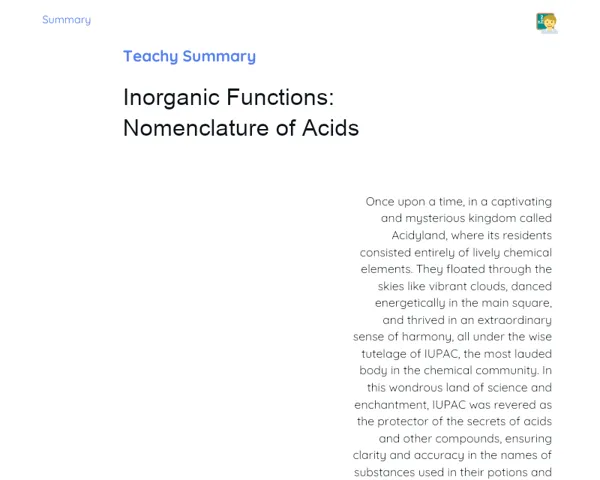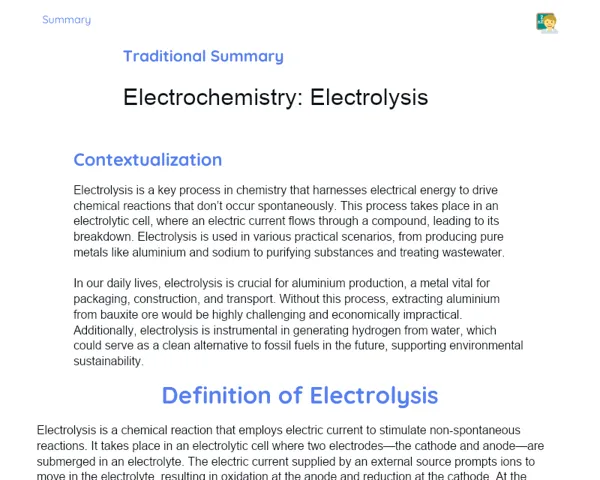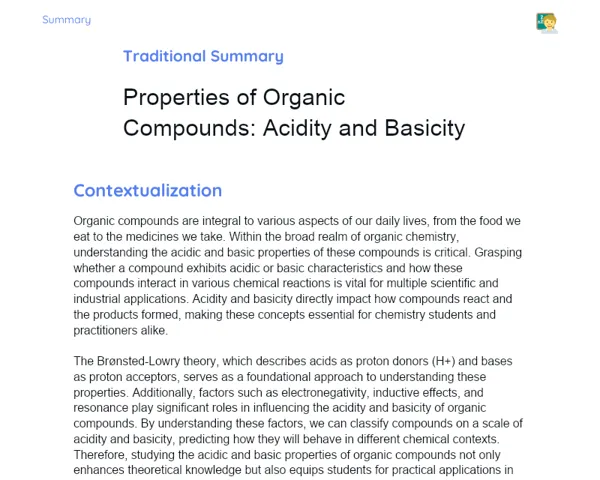Socioemotional Summary Conclusion
Goals
1. Accurately name nitro compounds using IUPAC nomenclature.
2. Differentiate the naming of nitro compounds from that of other organic compounds.
Contextualization
Did you know that nitro compounds are not just vital components in explosives like TNT, but they also play key roles in producing medicines and dyes? Learning how to name these compounds will not only deepen your understanding of Organic Chemistry, but it will also uncover a wealth of practical applications that are relevant in your daily life and future career. Let’s dive in together and unravel the intriguing world of nitro compounds! 🎉🔍
Exercising Your Knowledge
Definition of Nitro Compounds
Nitro compounds are organic compounds featuring one or more nitro groups (-NO2) bonded to a carbon atom. Known for their explosive nature, these compounds are crucial in creating explosives, pharmaceuticals, and dyes. The nitro group's presence gives these compounds unique traits, making them quite reactive.
-
Nitro Functional Group (-NO2): This group has a double bond between nitrogen and one oxygen atom, while another oxygen forms a single bond with nitrogen. This structure grants these compounds high reactivity, particularly in combustion.
-
Industrial Uses: Nitro compounds are pivotal in manufacturing explosives like TNT (trinitrotoluene). They're also heavily relied upon in the pharmaceutical industry for creating medications and in dye production.
-
Socio-emotional Importance: Getting to grips with the reactivity of nitro compounds can help manage frustrations and stress during tough situations, encouraging innovative problem-solving.
Structure of Nitro Compounds
A nitro compound typically has the nitro functional group (-NO2) attached to either a carbon ring or an aliphatic chain. The spatial arrangement of this functional group has a direct impact on the compound's physical and chemical properties. For instance, having multiple nitro groups can significantly raise the energy density of the compound, making it more explosive.
-
Nitro Group Placement: The nitro group can bond with various carbon structures, like aromatic rings or aliphatic chains, which defines the compound's reactivity.
-
Physical Properties: Compounds with several nitro groups often have high melting and boiling points due to their polarized structures.
-
Socio-emotional Relevance: Examining the molecular structure of nitro compounds fosters critical thinking and problem-solving skills, essential for making informed decisions.
IUPAC Nomenclature for Nitro Compounds
The IUPAC naming convention for nitro compounds involves attaching the prefix 'nitro-' to the corresponding hydrocarbon name. It's important to number the main carbon chain to ensure that the nitro group has the lowest possible number. This systematic approach allows for accurate identification of compounds and aids in scientific communication.
-
Numbering Rules: The main carbon chain should be numbered in such a way that minimises the position of the nitro group. This is essential for correctly identifying the compound.
-
Use of the Prefix 'Nitro-': The prefix 'nitro-' is affixed to the hydrocarbon name. For instance, CH3NO2 is called 'nitromethane,' while C3H7NO2 is '1-nitropropane.'
-
Comparison with Other Compounds: Nitro compounds have specific nomenclature rules different from alcohols and ketones, so understanding these distinctions is vital to avoiding confusion.
-
Socio-emotional Impact: Mastering IUPAC nomenclature boosts self-confidence and enhances communication skills in scientific contexts and beyond.
Key Terms
-
Nitro Compounds: Organic compounds containing one or more nitro groups (-NO2).
-
Nitro Functional Group (-NO2): Characterized by a double bond between nitrogen and one oxygen, and a single bond with another oxygen.
-
IUPAC Nomenclature: A naming system developed by the International Union of Pure and Applied Chemistry to standardize chemical names.
-
Trinitrotoluene (TNT): A powerful and well-known explosive made from three nitro groups bonded to a toluene ring.
For Reflection
-
How can a better understanding of nitro compounds influence your approach to tackling challenges in both academic and personal spheres?
-
In what ways can precision in IUPAC nomenclature improve your communication in group discussions and workplace scenarios?
-
How can you leverage knowledge of nitro compounds to promote responsible decision-making and effective problem-solving in your everyday life?
Important Conclusions
-
Nitro compounds are organic substances that comprise one or more nitro groups (-NO2) attached to a carbon atom.
-
The IUPAC naming system for nitro compounds involves adding 'nitro-' to the relevant hydrocarbon name, facilitating accurate compound identification.
-
Grasping the structure and nomenclature of nitro compounds is crucial not just in studying Organic Chemistry, but also for practical applications across various industries like pharmaceuticals and dye manufacture.
-
Analyzing nitro compound properties can cultivate essential socio-emotional skills, including problem-solving, self-assurance, and effective communication.
Impacts on Society
Nitro compounds significantly influence society, particularly in the pharmaceutical and dye sectors. They are critical in the development of medications that address various health issues. Furthermore, in the dye industry, these compounds are utilized to create vivid, long-lasting colours in fabrics, which directly impacts people's daily lives, from fashion choices to consumer goods. Understanding the chemistry of these compounds opens avenues for innovation and enhancement in industrial processes, leading to better quality and safer products.
Having the skill to understand and apply the nomenclature of nitro compounds can really boost students' confidence in their academic and scientific abilities. This confidence is vital when facing future challenges in both educational and professional environments. Knowing that the knowledge gained can be applied in real-life scenarios, like creating life-saving medications or developing new materials, instils a sense of purpose and drives the desire to continue learning about organic chemistry.
Dealing with Emotions
To effectively manage emotions while grappling with the study material, I recommend using the RULER approach. Begin by recognising your feelings while studying nitro compounds: are you feeling frustrated, confused, or perhaps even excited? Try to identify what triggers these emotions; for example, frustration may arise from the complexity of the topic. Label these emotions and pinpoint what they are. Then, find constructive ways to express your feelings: have conversations with friends or educators about your challenges. Lastly, use techniques like deep breathing, taking short breaks, or meditating to regulate these emotions. This exercise not only aids in better understanding your feelings but also enhances your capability to navigate tough situations in the future.
Study Tips
-
Create visual summaries using mind maps to showcase the connections and structures of nitro compounds. This will aid in better memorization and understanding of the content.
-
Hone your IUPAC naming skills by tackling exercises from various sources. Regular practice is key to solidifying your knowledge.
-
Collaborate in study groups: discussing topics with classmates can clarify uncertainties and boost both communication and teamwork abilities.



